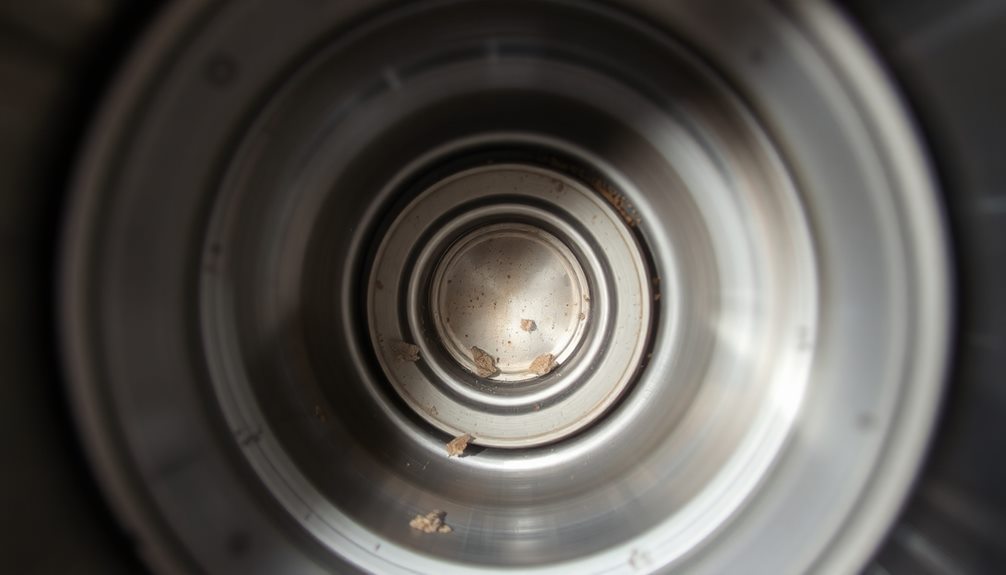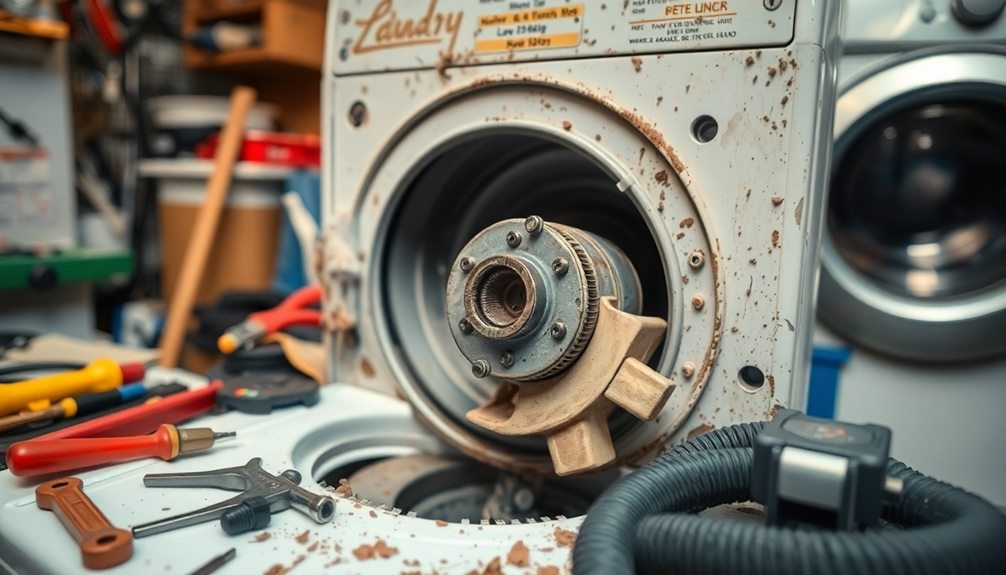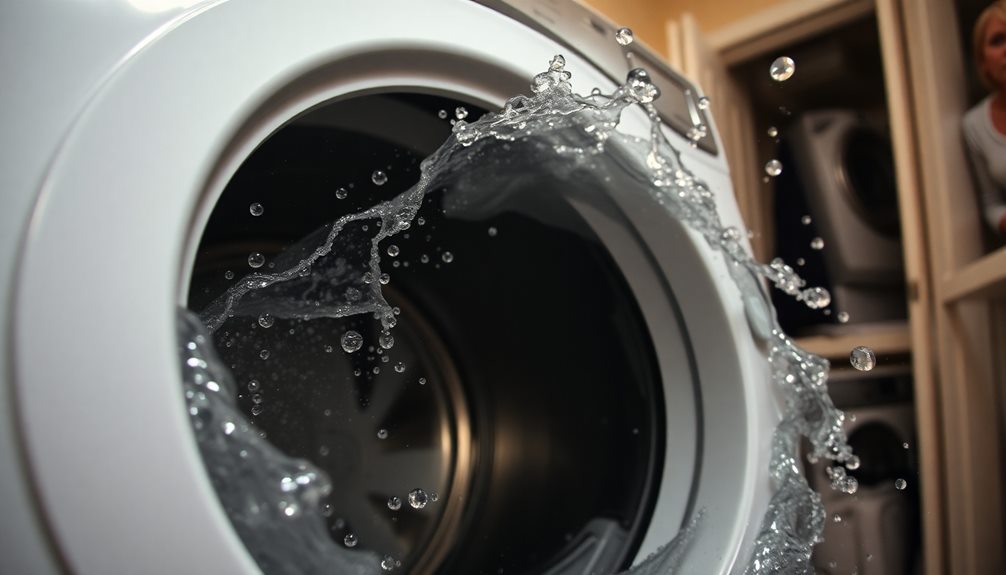If your top load washer is loud during the spin cycle, it could be due to several mechanical issues. Worn main tub bearings often cause grinding noises, while a damaged drive pulley can lead to rattling sounds. You might also hear clunking from worn motor couplings or squealing from a loose drive belt. It's important to check if the load is balanced or if any components are loose. Ignoring these noises can lead to more significant problems. Understanding the root cause can help you prevent further issues down the line. Let's explore these potential problems and solutions further.
Key Takeaways
- Worn main tub bearings can cause loud banging or squealing noises during the spin cycle, indicating potential replacement needs.
- A damaged or loose drive pulley may create rattling and grinding noises, affecting spinning efficiency.
- Failed motor couplings can result in unusual clunking sounds and insufficient spinning, often requiring straightforward replacement.
- Issues with the drive belt, such as tears or looseness, can lead to squealing and decreased washing performance.
- Inspecting and tightening loose components, like shock absorbers and suspension springs, can help reduce excessive noise during operation.
Common Causes of Noise

When you notice noise during the spin cycle of your top load washer, it's often due to several common issues. One major culprit could be worn main tub bearings. As they deteriorate, you might hear grinding or rumbling sounds that signal it's time for a replacement.
Another source of the washer making a loud racket could be a damaged or loose drive pulley. You should inspect it for cracks or tightness, as these can create rattling noises when the drum moves.
Worn motor couplings can also contribute to the problem. They connect the motor to the transmission, and if they fail, you'll hear loud clunks or experience operational issues.
Additionally, problems with the clutch assembly can lead to scraping sounds and ineffective spins, often indicated by brake dust accumulating under the washer.
Diagnosing the Issue

To diagnose the noise your top-load washer makes during the spin cycle, start by inspecting for loose components that could be rattling around.
Next, check the load balance; uneven loads can create excessive vibrations and noise.
Inspect for Loose Components
A thorough inspection of your top load washer is essential for diagnosing noise issues during the spin cycle. Start by checking all visible screws and bolts to guarantee they're tightened. Loose components can lead to excessive vibrations, resulting in unwanted noise.
Pay special attention to the drive pulley; if it's loose or damaged, it can create rattling sounds that become amplified as the washer spins.
Next, examine the motor coupling for any cracks or breaks. A worn motor coupling can cause loud clunks or operational issues that contribute to the noise.
Also, assess the condition of the drive belt. If it's worn or loose, you might hear squealing or whining sounds while the washer is in action.
Check Load Balance
An unbalanced load can wreak havoc on your top load washer, leading to excessive shaking and loud noises during the spin cycle.
To diagnose this issue, you'll want to check the load balance inside the drum. Make sure the items are evenly distributed; place heavier items opposite lighter ones to promote stability. If your washer continues to make noise, pause the cycle and manually redistribute the load before resuming. This simple adjustment can greatly reduce vibrations and noise levels.
Overloading the washer or mixing heavy and light fabrics can worsen the imbalance, making the noise even more pronounced.
Regularly monitoring and adjusting your load distribution is essential, as it can prevent undue strain on the machine's components. This not only helps maintain quieter operation but also extends the overall lifespan of your washer.
Examine Worn Parts
If adjusting the load balance hasn't resolved the noise issue, it's time to examine worn parts within your washer.
Start by inspecting the main tub bearing for any signs of wear or rust. A failing tub bearing often causes grinding noises during the spin cycle, which can be quite alarming.
Next, check the drive pulley for looseness or cracks. If it's damaged, you'll likely hear rattling sounds as it rotates, indicating it may need replacement.
Don't overlook the motor coupling either; any signs of wear or cracks here can lead to loud clunks and operational issues.
Also, assess the condition of the drive belt. Look for tears or cracks, as a worn belt can generate squealing or whining sounds during operation.
Finally, regularly inspect components like shock absorbers and suspension springs. If these parts are weak or detached, they can contribute greatly to excessive noise in your washer.
Repairing Major Components

When dealing with noise during the spin cycle of your top load washer, repairing major components often becomes necessary to restore quiet operation. One common culprit is the drive pulley. If it's damaged or loose, you'll likely experience increased noise during the spin.
Replacing a faulty drive pulley requires disassembling the washer, so be prepared for a bit of a project.
Another major component to evaluate is the motor coupling. This part connects the motor to the transmission and is relatively easy to replace if you notice any signs of wear or breakage. If you're handy, you might tackle this job yourself.
The clutch also plays a crucial role; however, replacing it involves disassembling the washer and ensuring proper alignment to minimize noise during the spin cycle.
Finally, don't overlook the drive belt. If it's worn, you can easily source a new one online and replace it yourself, which can resolve annoying squealing or whining sounds.
Taking the time to address these major components can greatly improve your washer's performance and reduce unwanted noise.
Additional Parts to Inspect

Many homeowners overlook additional parts that can contribute to noise during the spin cycle of a top load washer. It's important to inspect the shock absorbers first. If these components are weak or broken, they can't effectively dampen the tub's movement, leading to loud banging noises.
Next, check the drive belt. A worn or damaged belt can cause slippage, resulting in unusual noises while the washer operates.
Additionally, don't forget about the suspension springs. If they're worn or detached, they'll create instability and excessive vibrations, amplifying the noise during the spin cycle.
You should also inspect the agitator directional cogs. If these cogs are damaged, they can produce grinding sounds, indicating that they need replacement.
Maintenance Tips for Longevity

Maintaining your top load washer is essential for guaranteeing its longevity and performance. Start with regular lubrication of the main tub bearing. This simple maintenance tip reduces wear and prevents excessive noise during spin cycles, greatly extending its lifespan.
Next, inspect and clean the drain pump periodically. A clogged pump can lead to intermittent noise and affect your washer's overall performance.
Also, check the tension and condition of the drive belt; a well-maintained belt operates more quietly and efficiently.
Don't forget to monitor the shock absorbers and suspension springs. If you notice any signs of fatigue or leaks, replace them immediately to maintain stability and minimize noise.
Defective Tub Bearing Symptoms

Regular maintenance can help you spot issues before they escalate, but if you hear loud banging or squealing noises during the spin cycle, it's worth investigating the tub bearing. A defective tub bearing often manifests through these alarming sounds, signaling significant wear or rusting of the component.
As your washer reaches higher spin speeds, you may notice excessive wobbling of the drum, which further indicates a failing tub bearing. Accumulation of water, detergent, and debris can lead to rust, compromising the bearing's function and resulting in unusual noises during operation.
If you're experiencing these symptoms, it's essential to take action. Ignoring them could escalate to a situation where the entire tub assembly needs replacement, as accessing the tub bearing for a straightforward fix can be quite complex.
To avoid such costly repairs, make it a habit to perform regular checks and maintenance on your tub bearing. By doing so, you can help prevent premature failure, extend the lifespan of your washing machine, and enjoy quieter spin cycles.
Don't let a defective tub bearing disrupt your laundry routine; stay proactive and attentive to your washer's needs.
Damaged Drive Pulley Effects

If your washer's drive pulley is damaged, you might notice loud rattling or grinding noises during the spin cycle.
Regular inspection is key to catching any signs of wear before they lead to bigger problems.
Knowing how to identify these symptoms and understanding repair options can save you time and hassle down the line.
Symptoms of Damage
When you notice rattling or clunking noises during the spin cycle, it's likely a sign of a damaged drive pulley. This damage could mean the pulley is cracked or loose, affecting how your washer operates. If the drive pulley is compromised, you might experience uneven spinning, leading to excessive vibrations and a louder operation.
Here are some common symptoms of a failing drive pulley you should be aware of:
- Irregular spinning speeds: Your washer drum may not maintain a consistent speed during the spin cycle.
- Unusual sounds: The noise might start softly but can worsen as the cycle progresses.
- Increased vibrations: You may feel your washer shaking more than usual during operation.
- Poor washing performance: Clothes mightn't come out as clean or as dry due to ineffective drum movement.
Regular inspection of the drive pulley can help you catch these issues early, preventing further damage and costly repairs.
If you suspect your drive pulley is damaged, addressing it promptly is essential for restoring your washer's performance and reducing that annoying noise.
Inspection and Repair Tips
A thorough inspection of your washer's drive pulley is essential for identifying issues before they escalate. If you notice loud noises during the spin cycle, it could indicate a damaged drive pulley. Look for visible cracks or looseness, as these are signs of a failing pulley. Pay particular attention to how the sounds change at higher spin speeds; if they become more pronounced, it's time to act.
Regularly checking the drive pulley can prevent further damage to your washer's drum and motor. A malfunctioning pulley puts extra strain on these components, leading to costly repairs. If you identify damage, replacing the drive pulley is vital. This process involves disassembling the washer, so make sure to follow manufacturer guidelines for proper installation and alignment.
Timely attention to a damaged drive pulley not only reduces loud noises but also extends your washing machine's lifespan. By addressing these issues promptly, you can avoid additional wear on surrounding parts and keep your washer running smoothly.
Don't let a small problem turn into a major headache—inspect your drive pulley regularly and take action when needed.
Signs of Worn Drive Belt

Understanding the signs of a worn drive belt can save you from frustrating laundry days filled with noise. If your washer is making unusual sounds during the spin cycle, it might be time to inspect the drive belt.
Here are a few common indicators of wear:
- Squealing or whining noises: These sounds often mean the drive belt is loose or damaged.
- Visible damage: Cracks, fraying, or tears on the belt surface are clear signs that it needs attention.
- Loud clunking sounds: If the drive belt has become excessively loose, it may slip, causing the washer drum to struggle while spinning.
- Decreased performance: A worn drive belt can lead to less efficient washing, making your laundry days longer.
Regularly checking the drive belt during maintenance can help you catch these issues early.
Replacing a worn drive belt is usually a straightforward DIY task that can considerably reduce noise and improve your washer's performance.
Don't let a loud spin cycle ruin your laundry experience; stay proactive and keep an eye on your drive belt!
Failed Motor Coupling Indicators

If your top load washer is making unusual rumbling or clunking noises during the spin cycle, it might be a sign of a failed motor coupling.
You should inspect the coupling for wear and diagnose any operational issues, like the drum not spinning correctly.
Understanding the replacement process can help you restore your washer's functionality without much hassle.
Symptoms of Failure
Rumbling noises during the spin cycle can be a clear indicator of a failed motor coupling in your top load washer. This loud sound often signals a disconnect between the motor and transmission, meaning it's time to pay attention.
If you notice any of these symptoms, it might be time to investigate further:
- The washer basket doesn't spin at all, leaving your clothes wet.
- You hear unusual clunking sounds, suggesting the drive forks are struggling.
- The basket spins slower than usual, indicating the motor coupling may be slipping.
- Your washer pauses intermittently during cycles, disrupting your laundry routine.
Recognizing these symptoms early can save you from more significant issues down the line. A worn motor coupling can lead to operational problems, and neglecting it could result in costly repairs.
Regularly inspecting the motor coupling in your direct-drive washer guarantees you catch wear before it leads to mechanical failures. If you're experiencing any of these loud noises or performance issues, addressing the motor coupling sooner rather than later is crucial for maintaining your washer's efficiency.
Inspection and Diagnosis
Inspecting your top load washer for motor coupling failure involves paying close attention to specific indicators that can signal trouble.
One major sign is a loud clunking noise during the spin cycle, which suggests there's a connection issue between the motor and transmission. If you notice your washer struggling to reach spin speed or experiencing excessive vibrations, these could also be symptoms of a worn motor coupling.
Regular inspections are essential, as wear can cause the drive forks to slip, leading to a rumbling noise during the basket's rotation.
Keep an ear out for any unusual sounds; loud noise often points directly to motor coupling problems. If you hear these clunking or rumbling sounds consistently, it's time to take a closer look.
Replacement Process Explained
Hearing loud clunking or rumbling noises during the spin cycle is a clear indication that your motor coupling may be failing. This issue often results from a disconnect between the motor and transmission, leading to poor performance.
To address this, you'll need to replace the worn motor coupling. Here's what to look out for:
- Difficulty in spinning the washer drum
- A noticeable slipping sensation during operation
- Rubber or plastic pieces wearing down over time
- Unusual noises that weren't present before
To replace the failed motor coupling, start by disconnecting the power supply to your washer. Next, remove the cabinet to access the motor and transmission area.
Carefully inspect the coupling for any signs of damage or wear. Once you've assessed its condition, simply replace the old coupling with a new one.
Regularly inspecting your motor coupling can help you catch problems early and extend your washer's lifespan. By staying proactive, you can guarantee smoother operation and fewer disruptions during your laundry days.
When to Seek Professional Help

When your top load washer starts making persistent and unusual noises during the spin cycle, it's vital to recognize when it's time to call in a professional. If you hear banging or any other loud noise that doesn't go away after your troubleshooting efforts, it might indicate a serious issue. Ignoring these sounds can lead to additional damage, so don't hesitate to seek help.
Signs of leaking or electrical problems accompanying loud noises are especially concerning and warrant immediate professional intervention for safety reasons.
Moreover, if your washer vibrates excessively and moves considerably during operation, it's likely a sign of mechanical failure that needs expert evaluation.
For washers older than 10-15 years that frequently exhibit noise issues, consulting a professional can clarify if repairs or a replacement would be more cost-effective.
In addition, if you notice abnormal noises related to major components like the motor or transmission, it's vital to get a professional assessment to guarantee proper diagnosis and repair.
Trust your instincts; when in doubt, getting professional help is the best way to make sure your washer runs smoothly and safely.
Frequently Asked Questions
Why Is My Top Load Washing Machine Loud When Spinning?
Your top load washing machine's loud spinning might stem from an unbalanced load, worn bearings, or foreign objects trapped in the drum. Regular maintenance helps prevent noise and guarantees your washer runs smoothly and efficiently.
Why Does My Washing Machine Sound Like a Jet Engine When Spinning?
When your washing machine roars like a jet engine, it's often due to unbalanced loads or worn parts. Check for foreign objects and verify everything's level to restore peace and keep laundry day enjoyable.
How to Tell if a Washing Machine Has Loose or Worn Out Drum Bearings?
To check for loose or worn drum bearings, manually move the drum. If it wobbles or shows lateral movement, listen for squeaks or bangs. These signs indicate the bearings may need inspection or replacement.
Is It Safe to Use a Noisy Washing Machine?
"A stitch in time saves nine." While using a noisy washing machine might be safe short-term, you should investigate the source of the noise. Ignoring it could lead to serious mechanical issues down the line.
Conclusion
Just like a ship steering through stormy seas, your top load washer deserves calm waters to function smoothly. If it's loud during the spin cycle, don't let the noise be a siren's call to despair. By diagnosing and repairing the underlying issues, you can guide your washer back to tranquil operation. Remember, a well-maintained vessel—er, washer—sails through chores with ease. If the storms persist, don't hesitate to call in a skilled captain for help.










